fuel YAMAHA FX SHO 2012 Owners Manual
[x] Cancel search | Manufacturer: YAMAHA, Model Year: 2012, Model line: FX SHO, Model: YAMAHA FX SHO 2012Pages: 116, PDF Size: 4.49 MB
Page 3 of 116

Important manual information
EJU37154
Declaration of Conformity for Personal Watercraft (PWC)
with the requirements of Directive 94/25/EC, as amended by Directive 2003/44/EC
Name of Engine Manufacturer:YAMAHA MOTOR CO., LTD.
Name / Title:H. Yamaji / President of YAMAHA MOTOR EUROPE N.V. Address:2500 Shingai, Iwata, Shizuoka 438-8501, Japan
Name of Authorised Representative:YAMAHA MOTOR EUROPE N.V.
Address:Koolhovenlaan 101, 1119 NC Schiphole-Rijk, The Netherlands
Name of Notified Body for exhaust and noise emission assessment:Luxcontrol SA
Address:1. avenue des Terres Rouges BP 349, Esch-sur-Alzette, L-4004. Luxembourg
Name of Notified Body for exhaust and noise emission assessment:SNCH
FA1800A-L / FX Cruiser SHO, FA1800-L / FX SHO0882
0499 ID Number:
ID Number:
Address:11, route de Luxembourg BP 32, Sandweiler, L-5230. Luxembourg
US-YAMA1001A212 Conformity assessment module used:
for construction:
for exhaust emissions:
for noise emissions:
DESCRIPTION OF CRAFT
DESCRIPTION OF ENGINEA
A
Craft model Identification Number, starting from :
Model name / Commercial name :C Design Category :Other Community Directives applied
Directive 2004/108/EC relating to electromagnetic compatibility (EMC).CISPR 12
Directive 2006/42/EC relating to Machinery.Standards
EN 61000-6-2
D
Aa
AaB+C
B+CB+D
B+DB+E
B+EB+F
B+FG
G
GH
H
H
Engine Type:
PWC engineCombustion cycle:
4 stroke
Fuel Type:
Petrol
ESSENTIAL REQUIREMENTS
IDENTIFICATION OF ENGINE COVERED BY THIS DECLARATION OF CONFORMITY
Name of engine model
6CSName / ID number of Notified Body
SNCH / 0499 EC Type–examination certificate number
SNCH*94/25*2003/44*0043*00
(identification of the person empowered to sign on behalf of the engine manufacturer or his authorised representative)
Signature and title:(or an equivalent marking)Date and place of issue:1st / January / 2012, Schiphol-Rijk, The Netherlands
Essential requirementsstandardsother normative
document / methodtechnical filePlease specify in more detail
(* = mandatory standard)
I.A design and construction EN ISO 13590
I.B exhaust emission*EN ISO 8178-1
I.C noise emission*EN ISO 14509
*
*
This declaration of conformity is issued under the sole responsibility of the PWC manufacturer. I declare on behalf of the PWC
manufacturer that the craft model and engine(s) mentioned above complies (comply) with all applicable essential
requirements in the way specified and is (are) in conformity with the type(s) for which above mentioned EC type-examination
certificate(s) has (have) been issued.
ID Number:
ID Number:
UF2S70E0.book Page 1 Wednesday, December 7, 2011 3:56 PM
Page 5 of 116

Table of contents
General and important labels ........... 1
Identification numbers .................... 1
Primary Identification (PRI-ID)
number ........................................... 1
Craft Identification Number (CIN) ...... 1
Engine serial number ........................ 1
Manufactured date label .................... 2
Model information ........................... 2
Builder’s plate .................................... 2
Important labels .............................. 4
Warning labels ................................... 5
Other labels ....................................... 9
Safety information ........................... 11
Limitations on who may operate
the watercraft ............................ 11
Cruising limitations ....................... 12
Operation requirements ............... 13
Recommended equipment ........... 15
Hazard information ....................... 16
Watercraft characteristics ............. 16
Water-skiing ................................. 18
Safe boating rules ........................ 19
Enjoy your watercraft
responsibly ................................ 20
Description....................................... 21
Watercraft glossary ...................... 21
Location of main components ...... 22
Control function operation ............. 26
Watercraft control functions ......... 26
Remote control transmitter .............. 26
Yamaha Security System ................ 27
Engine stop switch .......................... 28
Engine shut-off switch ..................... 28
Start switch ...................................... 28
Throttle lever ................................... 29
Steering system ............................... 29
Adjustable tilt steering system ......... 30
Cooling water pilot outlets ............... 30
Water separator ............................... 31
Watercraft operation ....................... 32
Watercraft operation functions ..... 32
Shift system ..................................... 32
Quick Shift Trim System
(Q.S.T.S.) ..................................... 33
Watercraft operation modes ......... 35
Low RPM Mode ............................... 35
No-wake mode ................................ 36
Cruise assist .................................... 37
Instrument operation ...................... 40
Multifunction information center ... 40
Analog speedometer/tachometer .... 40
Information display .......................... 41
Multifunction display
(FX Cruiser SHO) ......................... 45
Equipment operation ...................... 49
Equipment .................................... 49
Seats ............................................... 49
Handgrip .......................................... 50
Reboarding grip ............................... 50
Reboarding step .............................. 50
Bow eye ........................................... 51
Stern eyes ....................................... 51
Cleat ................................................ 51
Pull-up cleats (FX Cruiser SHO) ...... 52
Storage compartments .................... 52
Fire extinguisher holder and
cover ............................................ 57
Operation and handling
requirements ................................... 58
Fuel requirements ........................ 58
Fuel ................................................. 58
Engine oil requirements ............... 60
Engine oil ......................................... 60
Draining the bilge water ............... 61
Draining the bilge water on land ...... 61
Draining the bilge water on water .... 62
UF2S70E0.book Page 1 Wednesday, December 7, 2011 3:56 PM
Page 26 of 116

Safety information
20
EJU30991
Enjoy your watercraft
responsibly
You share the areas you enjoy when riding
your watercraft with others and with nature.
So your enjoyment includes a responsibility to
treat these other people, and the lands, wa-
ters, and wildlife with respect and courtesy.
Whenever and wherever you ride, think of
yourself as the guest of those around you. Re-
member, for example, that the sound of your
watercraft may be music to you, but it could be
just noise to others. And the exciting splash of
your wake can make waves others won’t en-
joy.
Avoid riding close to shoreline homes and wa-
terfowl nesting areas or other wildlife areas,
and keep a respectful distance from fisher-
men, other boats, swimmers, and populated
beaches. When travel in areas like these is
unavoidable, ride slowly and obey all laws.
Proper maintenance is necessary to ensure
that the exhaust emission and sound levels of
your watercraft will continue to be within regu-
lated limits. You have the responsibility to
make sure that the recommended mainte-
nance in this owner’s/operator’s manual is
carried out.
Remember, pollution can be harmful to the
environment. Do not refuel or add oil where a
spill could cause damage to nature. Remove
your watercraft from the water and move it
away from the shoreline before refueling. Dis-
pose of water and any fuel and oil residue in
the engine compartment according to local
regulations. And keep your surroundings
pleasant for the people and wildlife that share
the waterways: don’t litter.
When you ride responsibly, with respect and
courtesy for others, you help ensure that ourwaterways stay open for the enjoyment of a
variety of recreational opportunities.
UF2S70E0.book Page 20 Wednesday, December 7, 2011 3:56 PM
Page 27 of 116

Description
21
EJU40302
Watercraft glossary
Trolling speed
“Trolling” is the lowest maneuvering speed. You are applying little or no throttle. The watercraft
is down in the water, and there is no wake.
Sub-planing speed
“Sub-planing” is a medium speed. The bow of the watercraft is slightly up from the water sur-
face, but you are still traveling through the water. There is a wake.
Planing speed
“Planing” is a faster speed. The watercraft is more level and is skimming on top of the water.
There is a wake.
Bow
The front end of the watercraft.
Stern
The rear end of the watercraft.
Starboard
The right side of the watercraft when facing forward.
Port
The left side of the watercraft when facing forward.
Bilge water
Water that has collected in the engine compartment.
Yamaha Engine Management System (YEMS)
YEMS is an integrated, computerized management system that controls and adjusts ignition
timing, fuel injection, engine diagnostics, and the off-throttle steering (OTS) system.
UF2S70E0.book Page 21 Wednesday, December 7, 2011 3:56 PM
Page 28 of 116
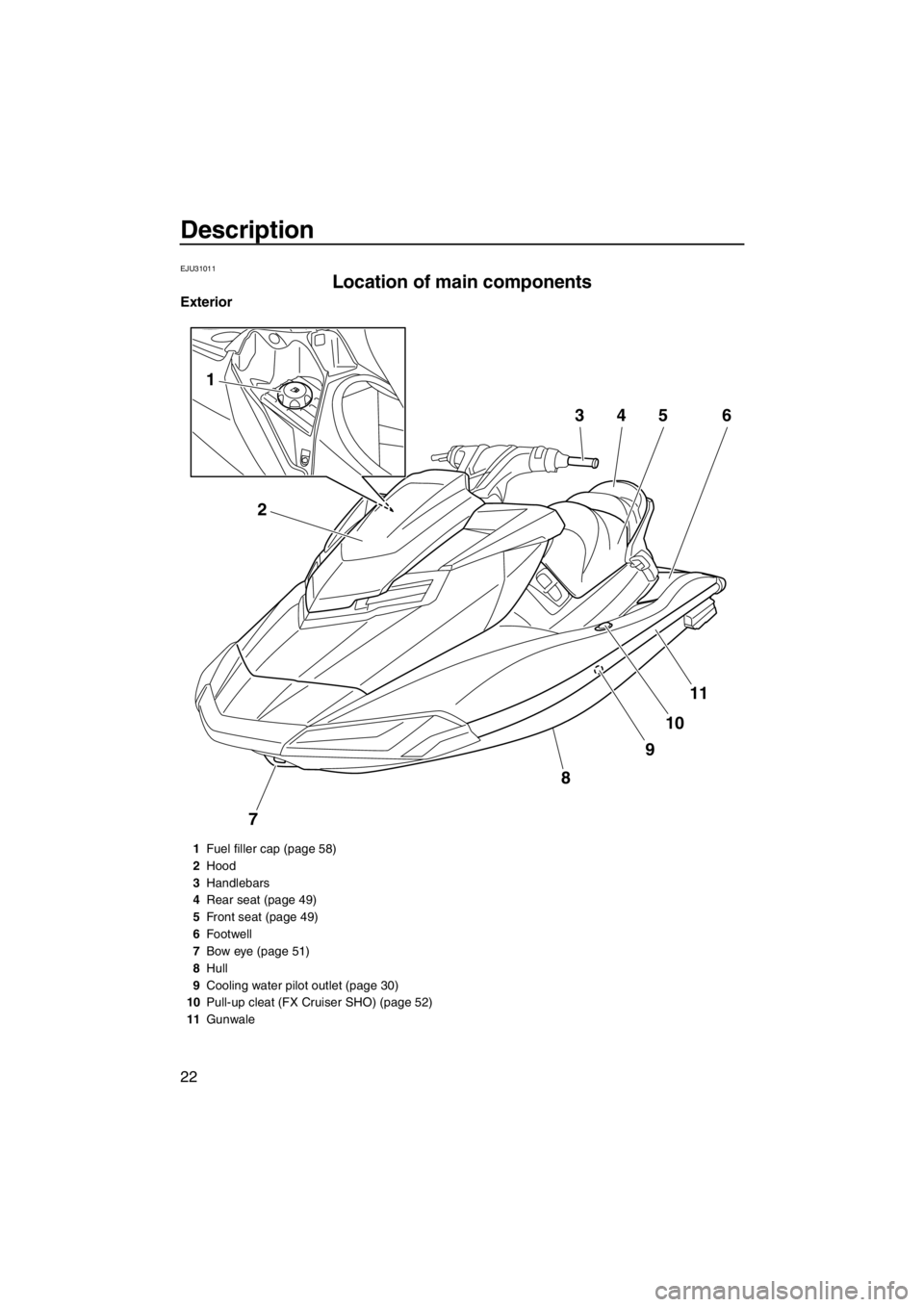
Description
22
EJU31011
Location of main components
Exterior
7
8
9
10
11
2
1
3456
1Fuel filler cap (page 58)
2Hood
3Handlebars
4Rear seat (page 49)
5Front seat (page 49)
6Footwell
7Bow eye (page 51)
8Hull
9Cooling water pilot outlet (page 30)
10Pull-up cleat (FX Cruiser SHO) (page 52)
11Gunwale
UF2S70E0.book Page 22 Wednesday, December 7, 2011 3:56 PM
Page 31 of 116
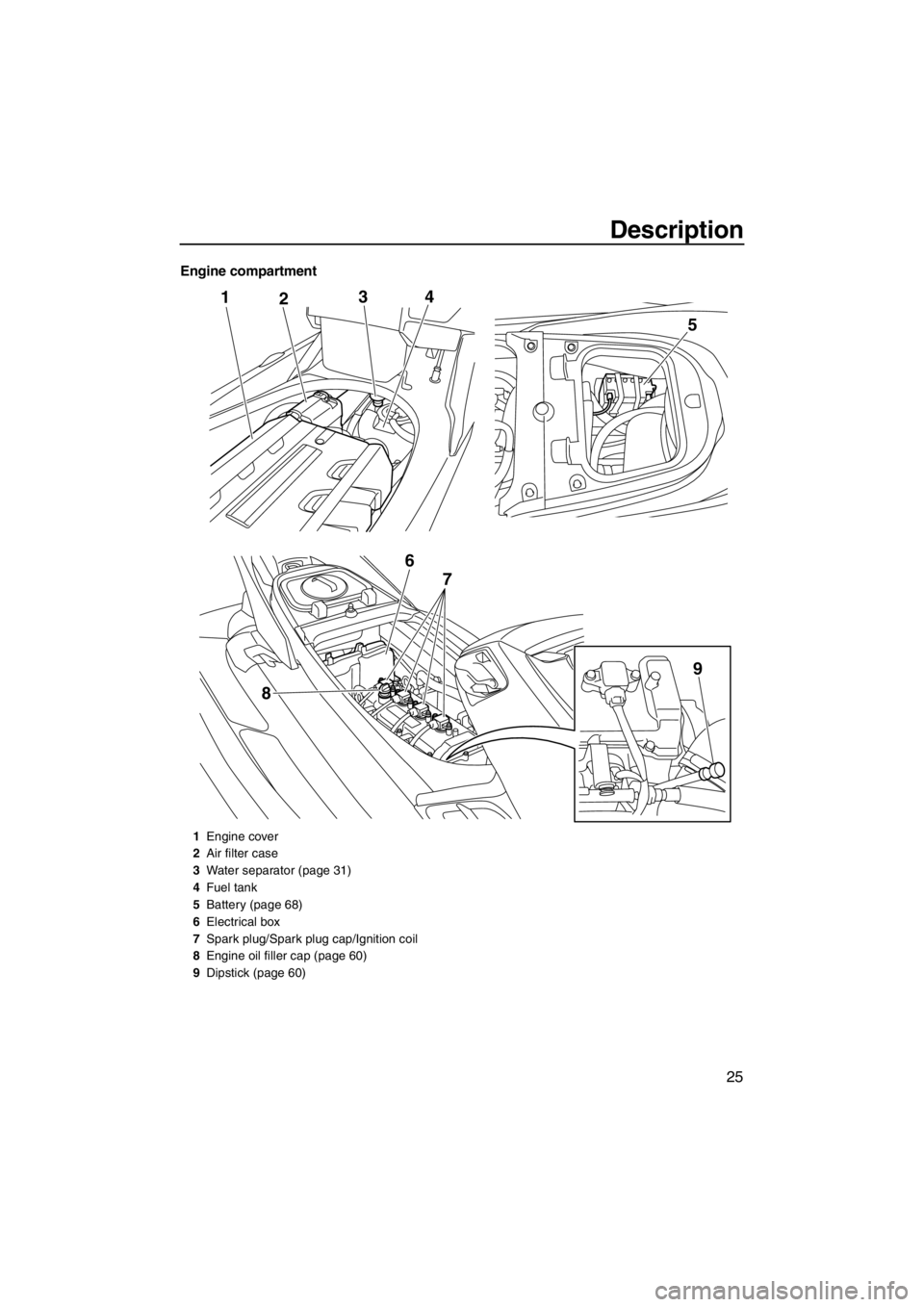
Description
25
Engine compartment
124
8
5
3
6
7
9
1Engine cover
2Air filter case
3Water separator (page 31)
4Fuel tank
5Battery (page 68)
6Electrical box
7Spark plug/Spark plug cap/Ignition coil
8Engine oil filler cap (page 60)
9Dipstick (page 60)
UF2S70E0.book Page 25 Wednesday, December 7, 2011 3:56 PM
Page 37 of 116
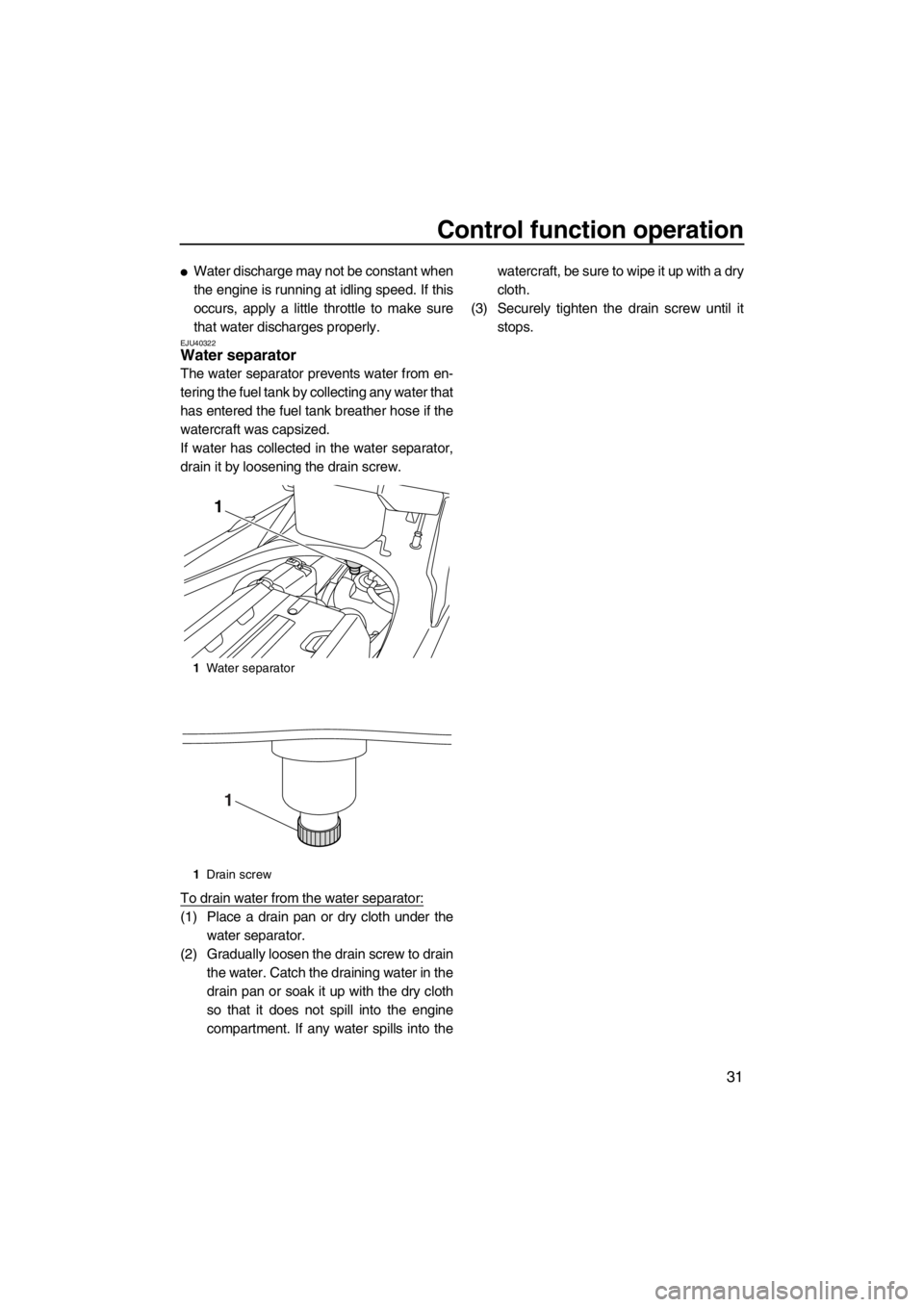
Control function operation
31
●Water discharge may not be constant when
the engine is running at idling speed. If this
occurs, apply a little throttle to make sure
that water discharges properly.
EJU40322Water separator
The water separator prevents water from en-
tering the fuel tank by collecting any water that
has entered the fuel tank breather hose if the
watercraft was capsized.
If water has collected in the water separator,
drain it by loosening the drain screw.
To drain water from the water separator:
(1) Place a drain pan or dry cloth under the
water separator.
(2) Gradually loosen the drain screw to drain
the water. Catch the draining water in the
drain pan or soak it up with the dry cloth
so that it does not spill into the engine
compartment. If any water spills into thewatercraft, be sure to wipe it up with a dry
cloth.
(3) Securely tighten the drain screw until it
stops.
1Water separator
1Drain screw
1
1
UF2S70E0.book Page 31 Wednesday, December 7, 2011 3:56 PM
Page 47 of 116

Instrument operation
41
To switch to the tachometer from the speed-
ometer:
Push the “SPEED/RPM” button for at least 1
second after the multifunction information
center is activated. When the meter switches
to the analog tachometer function, the “RPM”
indicator light comes on.
Analog speedometer
The analog speedometer shows the water-
craft speed against water.
The small inner numbers on the meter show
the watercraft speed in kilometers per hour
“km/h” and the large outer numbers show the
speed in miles per hour “mph”.
The “SPEED” indicator light comes on when
the analog speedometer is selected.
To switch to the speedometer from the ta-
chometer:
Push the “SPEED/RPM” button for at least 1
second after the multifunction information
center is activated. When the meter switches
to the analog speedometer function, the
“SPEED” indicator light comes on if “km/h” are
selected as the display units. The “SPEED”
indicator light blinks three times, then comes
on, if “mph” are selected as the display units.(See page 41 for information on switching the
digital speedometer display units.)
EJU35024Information display
The information display shows watercraft op-
erating conditions.
EJU42360Digital speedometer
The digital speedometer shows the watercraft
speed against water.
By switching the display units, the speed can
be shown in kilometers per hour (km/h) or
miles per hour (mph).
1“SPEED/RPM” button
2“RPM” indicator light
2
1
1“SPEED/RPM” button
2“SPEED” indicator light
1Fuel level meter
2Fuel indicator
3Hour meter/voltmeter
4Digital speedometer
5Engine overheat warning indicator
6Check engine warning indicator
7Oil pressure warning indicator
2
1
123
567
4
UF2S70E0.book Page 41 Wednesday, December 7, 2011 3:56 PM
Page 49 of 116
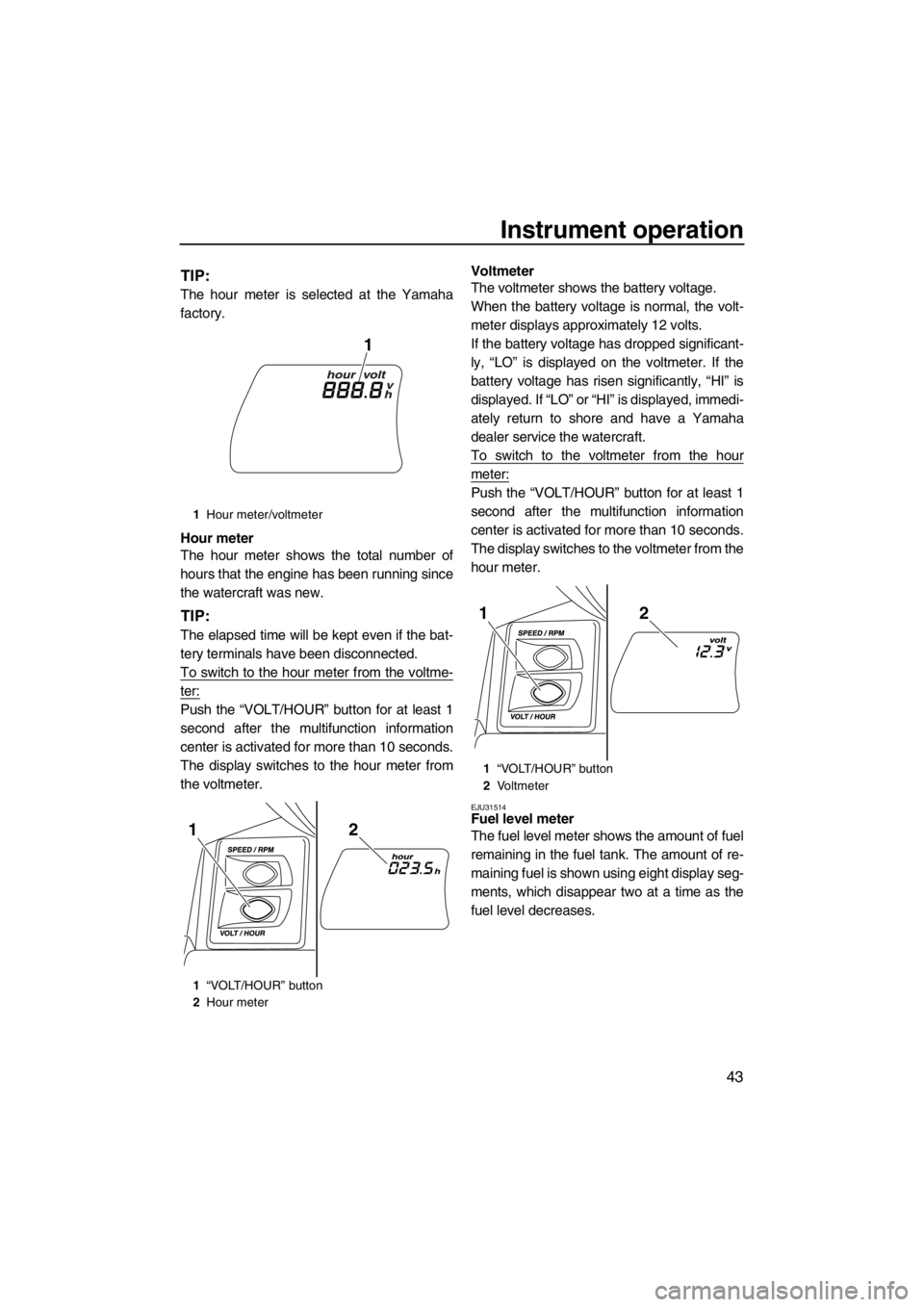
Instrument operation
43
TIP:
The hour meter is selected at the Yamaha
factory.
Hour meter
The hour meter shows the total number of
hours that the engine has been running since
the watercraft was new.
TIP:
The elapsed time will be kept even if the bat-
tery terminals have been disconnected.
To switch to the hour meter from the voltme-
ter:
Push the “VOLT/HOUR” button for at least 1
second after the multifunction information
center is activated for more than 10 seconds.
The display switches to the hour meter from
the voltmeter.Voltmeter
The voltmeter shows the battery voltage.
When the battery voltage is normal, the volt-
meter displays approximately 12 volts.
If the battery voltage has dropped significant-
ly, “LO” is displayed on the voltmeter. If the
battery voltage has risen significantly, “HI” is
displayed. If “LO” or “HI” is displayed, immedi-
ately return to shore and have a Yamaha
dealer service the watercraft.
To switch to the voltmeter from the hour
meter:
Push the “VOLT/HOUR” button for at least 1
second after the multifunction information
center is activated for more than 10 seconds.
The display switches to the voltmeter from the
hour meter.
EJU31514Fuel level meter
The fuel level meter shows the amount of fuel
remaining in the fuel tank. The amount of re-
maining fuel is shown using eight display seg-
ments, which disappear two at a time as the
fuel level decreases.
1Hour meter/voltmeter
1“VOLT/HOUR” button
2Hour meter
1
21
1“VOLT/HOUR” button
2Vo l t m e t e r
21
UF2S70E0.book Page 43 Wednesday, December 7, 2011 3:56 PM
Page 50 of 116
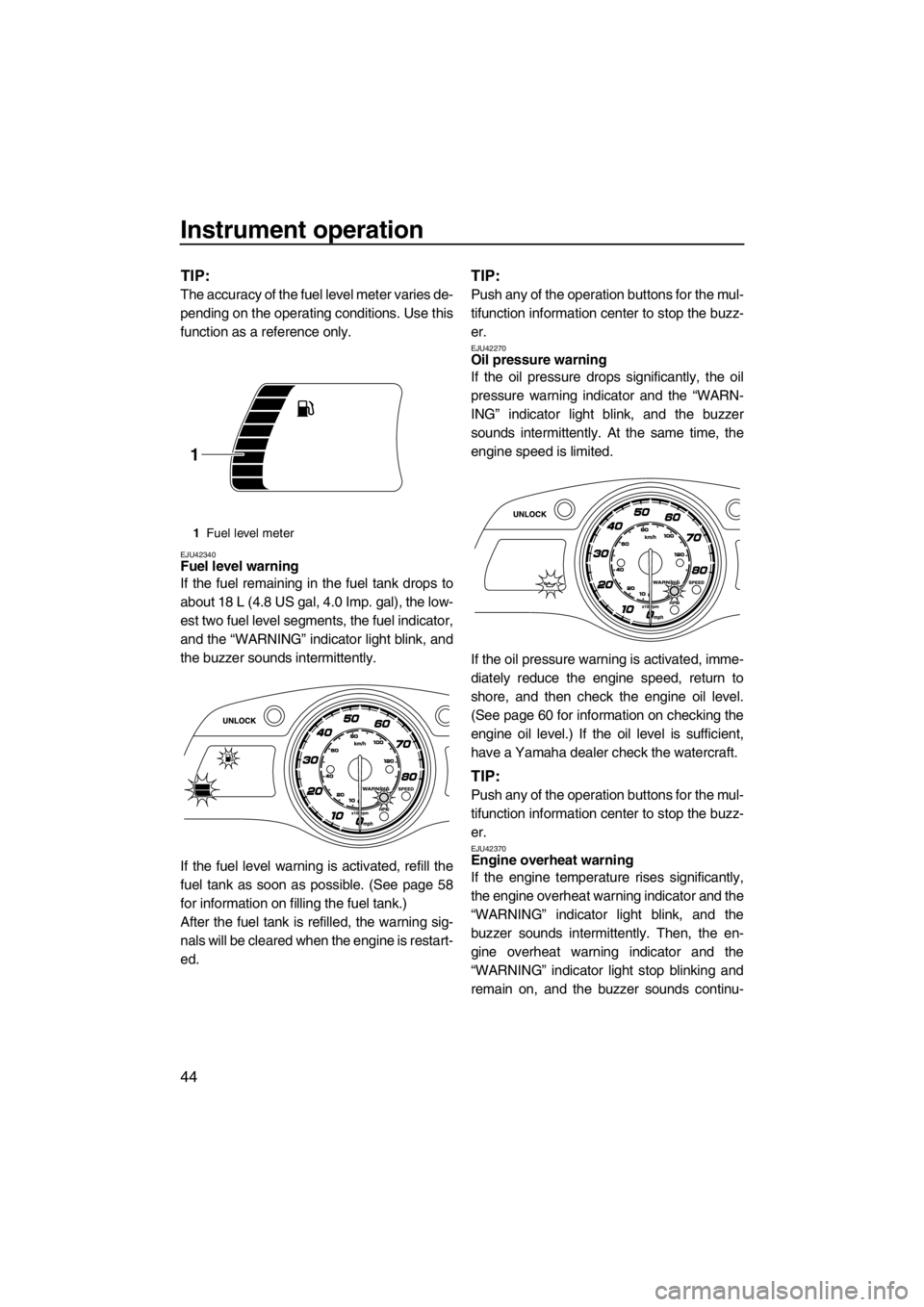
Instrument operation
44
TIP:
The accuracy of the fuel level meter varies de-
pending on the operating conditions. Use this
function as a reference only.
EJU42340Fuel level warning
If the fuel remaining in the fuel tank drops to
about 18 L (4.8 US gal, 4.0 Imp. gal), the low-
est two fuel level segments, the fuel indicator,
and the “WARNING” indicator light blink, and
the buzzer sounds intermittently.
If the fuel level warning is activated, refill the
fuel tank as soon as possible. (See page 58
for information on filling the fuel tank.)
After the fuel tank is refilled, the warning sig-
nals will be cleared when the engine is restart-
ed.
TIP:
Push any of the operation buttons for the mul-
tifunction information center to stop the buzz-
er.
EJU42270Oil pressure warning
If the oil pressure drops significantly, the oil
pressure warning indicator and the “WARN-
ING” indicator light blink, and the buzzer
sounds intermittently. At the same time, the
engine speed is limited.
If the oil pressure warning is activated, imme-
diately reduce the engine speed, return to
shore, and then check the engine oil level.
(See page 60 for information on checking the
engine oil level.) If the oil level is sufficient,
have a Yamaha dealer check the watercraft.
TIP:
Push any of the operation buttons for the mul-
tifunction information center to stop the buzz-
er.
EJU42370Engine overheat warning
If the engine temperature rises significantly,
the engine overheat warning indicator and the
“WARNING” indicator light blink, and the
buzzer sounds intermittently. Then, the en-
gine overheat warning indicator and the
“WARNING” indicator light stop blinking and
remain on, and the buzzer sounds continu-
1Fuel level meter
1
UF2S70E0.book Page 44 Wednesday, December 7, 2011 3:56 PM